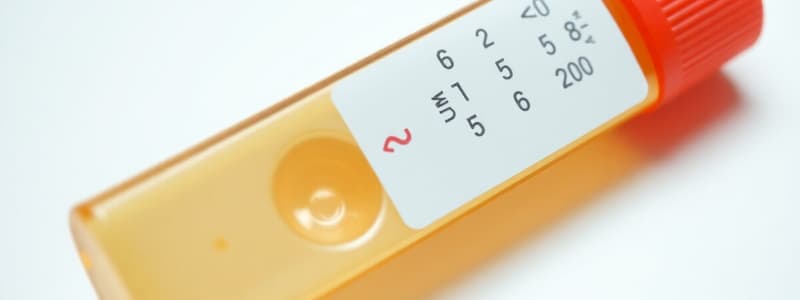Podcast
Questions and Answers
What is the most appropriate action to take if a urine sample cannot be examined within one hour?
What is the most appropriate action to take if a urine sample cannot be examined within one hour?
- Add a preservative such as formalin or chloroform. (correct)
- Keep it at room temperature for no more than 12 hours.
- Store it in a freezer until examination.
- Discard the sample and collect a new one.
Which of the following changes occurs to a non-preserved urine sample?
Which of the following changes occurs to a non-preserved urine sample?
- Stabilization of bilirubin levels.
- Increase in glucose levels.
- Evaporation of volatile substances. (correct)
- Decrease in bacterial count.
What volume of urine in adults indicates oliguria?
What volume of urine in adults indicates oliguria?
- Greater than 1500 mL per day.
- Less than 500 mL per day. (correct)
- Between 500 - 800 mL per day.
- Less than 300 mL per day.
Which physical examination characteristic indicates a normal urine sample?
Which physical examination characteristic indicates a normal urine sample?
What type of urine sample collection is considered most appropriate for analysis?
What type of urine sample collection is considered most appropriate for analysis?
Which of the following conditions is associated with polyuria?
Which of the following conditions is associated with polyuria?
What is the expected reaction (pH) of normal urine?
What is the expected reaction (pH) of normal urine?
Which of the following urinary constituents is organic?
Which of the following urinary constituents is organic?
What happens to ketone bodies in a non-preserved urine sample over time?
What happens to ketone bodies in a non-preserved urine sample over time?
Which of the following is NOT a method included in urine analysis?
Which of the following is NOT a method included in urine analysis?
Flashcards are hidden until you start studying
Study Notes
Urinalysis Overview
- Urinalysis is vital for diagnosing diseases, assessing drug metabolism, and evaluating kidney efficiency.
- Common conditions identified through urinalysis include urinary tract infections (UTI).
Collection of Urine Sample
- Mid-stream urine is the preferred sample; a clean external area is essential before collection.
- First portion of urine should be discarded to avoid contamination.
- Samples must be collected in clean, sterile containers labeled with patient information.
- Urine should be examined within one hour or refrigerated for up to 24 hours. For longer storage, preservatives like formalin or chloroform are necessary.
Changes in Non-Preserved Urine Samples
- Increase in bacterial count.
- Decrease in glucose levels.
- Conversion of urea to ammonia, raising pH levels.
- Loss of volatile substances and decrease in ketone bodies like acetone due to evaporation.
- Degradation of photosensitive substances like bilirubin.
- Decomposition of red blood cells (RBCs), white blood cells (WBCs), and proteins.
Urine Formation Process
- Comprises three main stages:
- Glomerular filtration (producing ultrafiltrate).
- Tubular reabsorption.
- Tubular secretion.
Normal Urine Constituents
- Organic: Urea and uric acid.
- Inorganic: Minerals such as calcium and chloride.
Urine Report Components
- Physical examination.
- Chemical examination.
- Microscopic examination.
Physical Properties of Urine
-
Volume: Typical daily output ranges from 800-1500 mL, influenced by fluid intake. Abnormalities include:
- Polyuria: >5 liters/day in diabetes mellitus; 10-15 liters/day in diabetes insipidus.
- Oliguria: <500 mL/day, common in dehydration.
- Anuria: Can indicate heart or kidney disease, or urinary tract obstruction.
-
Aspect: Normal urine is clear and transparent; turbidity may indicate albuminuria or prolonged standing, leading to precipitation of substances.
-
Reaction (pH): Normal urine pH is slightly acidic (6.4-6.8). Abnormal pH levels can indicate:
- Alkaline pH: Suggestive of UTI or use of antacids.
- Acidic pH: Associated with diabetic ketoacidosis and presence of ketone bodies.
Urine Examination Parameters
- Includes assessing aspects like odor, color, deposits (sediments), foam, specific gravity, and total solids.
Studying That Suits You
Use AI to generate personalized quizzes and flashcards to suit your learning preferences.




